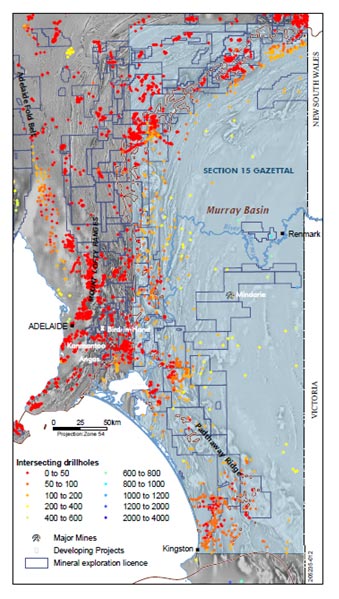The Geological Survey of South Australia partnered with MinEx CRC to undertake a National Drilling Initiative (NDI) project on the underexplored Delamerian Orogen.
This project included a geoscientific drilling program and additional research to understand the geology and mineral potential of both the Delamerian basement and overlying Murray Basin cover.
Twenty drillholes were undertaken using a mixture of a traditional drill rig and the new coiled tube drill rig. Drilling took place in the Cambrian-Ordovician Delamerian Orogen in the east of the State.
The project started with a geological review and data audit of the area to identify potential drilling areas. The full data set from that review is available for download.
Following the review, two geographical regions were selected for drilling – Quondong Vale and Alawoona. These areas provided a cross-section of geological and geophysical domains within the basement to the Murray Basin.
Until the NDI, exploration for base and precious metals within the Delamerian basement had been focused along the western margin of the Murray Basin. This project aimed to provide new constraints on the geological setting, deformational history, thickness of cover and prospective mineral systems of the basement beneath the Murray Basin.
Project data releases and publications
- New palynology results from the western Murray Basin, South Australia. This report includes palynological analysis and dating that has been conducted on sedimentary sequences from new MinEx CRC NDI drillholes, and on legacy drill samples from within and beneath the Murray Basin. The results have revealed variations in age (from late Middle Eocene to early Oligocene) and paleo-environment within lower units of the Murray Basin (Renmark Group) in NDI drillholes, as well as the first indications of Permian sediments in the Alawoona drilling area. Recognition of Permian under cover near the town of Karoonda suggests the extent of the Renmark Trough or Troubridge Basin need to be varied by more than 50 km.
- LA-ICP-MS detrital zircon geochronology from the Delamerian Orogen. A geochronological study of clastic metasedimentary units buried in the Delamerian Orogen region of South Australia has been undertaken to gain a better understanding of the age and provenance of these units and to assess their similarities to outcropping metasedimentary units located in other places within the Delamerian Orogen.
- Delamerian Orogen mineral potential mapping: the Cu-Mo-Au mineral system. Interim report. A mineral systems analysis for Cu-Mo-Au in the Delamerian Orogen has been conducted to assess the area’s potential for this type of mineral occurrence. A conceptual model was delineated and prospectivity maps were created. These maps can serve partially for drill and sampling campaign targeting.
- 40Ar/39Ar dating of low grade rocks of South Australia's Delamerian Orogen. Available via open access, this paper by Anthony Reid et al. details the record of structural re-activation on the western front of the Delamerian Orogen.
- Metallogenic Setting and Temporal Evolution of Porphyry Cu-Mo Mineralization and Alteration in the Delamerian Orogen, South Australia: Insights From Zircon U-Pb, Molybdenite Re-Os, and In Situ White Mica Rb-Sr Geochronology. A study by Wei Hong et al. focused on several porphyry mineral systems in the Delamerian orogen of eastern South Australia. It found that these prospects exhibit hallmarks of typical porphyry Cu-Mo deposits; classic hydrothermal alteration zonation, copper-bearing sulphides within veins, stockworks, and minor breccias. Alteration and mineralisation are associated with Early-Middle Ordovician granitic intrusions.
The study used various geochronometers to establish the timing of these events: zircon U-Pb ages indicated multiple pulses of granitoid emplacement from 490 to 460 million years ago. Molybdenite Re-Os geochronology revealed two mineralisation events at 480–475 and 470–460 million years ago. In-situ white mica Rb-Sr dating suggested hydrothermal pulses at 480–460 Ma, aligning with intrusive magmatism; and 450–435 Ma, possibly reflecting regional tectonothermal activity associated with events in the Lachlan Orogen.
Overall, the data support the idea that the Delamerian porphyry systems are a product of post-subduction processes, potentially driven by asthenospheric upwelling after the Delamerian Orogeny. The study suggests that porphyritic dykes and stocks with ages of 470 to 460 million years are promising exploration targets in this region.
- Multi-element whole rock geochemical analysis of Delamerian NDI samples are available via SARIG.
Presentations
Uncover Curnamona Symposium 2022
- Back-arc extension and inversion during the Delamerian Orogeny – Stacey Curtis
- The Delamerian NDI: Connecting south and eastern Australia – Tom Wise
Discovery Day 2021
- The Delamerian Orogen at 509 Mc – Stacey Curtis
- How we drilled: new technologies and workflow for Delamerian NDI program – Rian Dutch
- What we drilled: first look at new rocks from Gondwana’s Cambrian active margin – Tom Wise
- What geochronology and mineral chemistry can tell us about mineralisation potential of the Delamerian porphyry systems – Wei Hong
Discovery Day 2022
- First look at new data from the Delamerian national Drilling Initiative project: timing and petrogenesis of magmatic rocks – Dr Claire Wade
- Evidence of analogues: a framework for exploring the Delamerian Orogen – Tom Wise
Discovery Day 2023
- NDI update – Tom Wise



